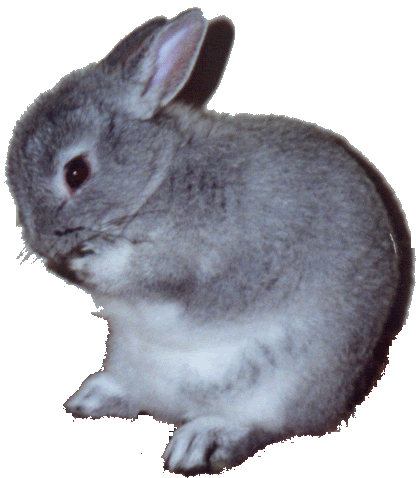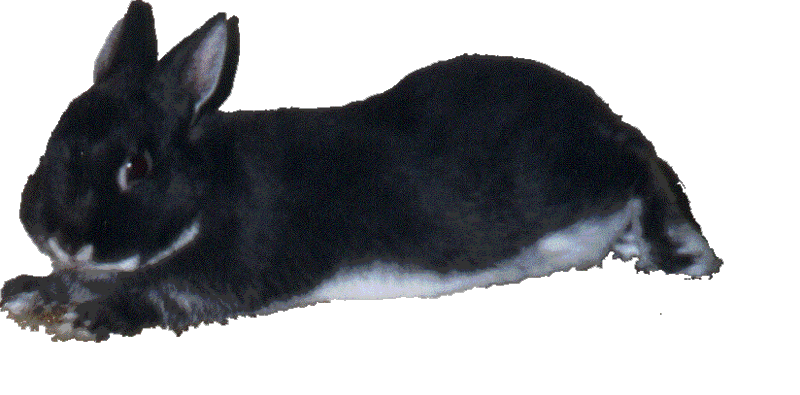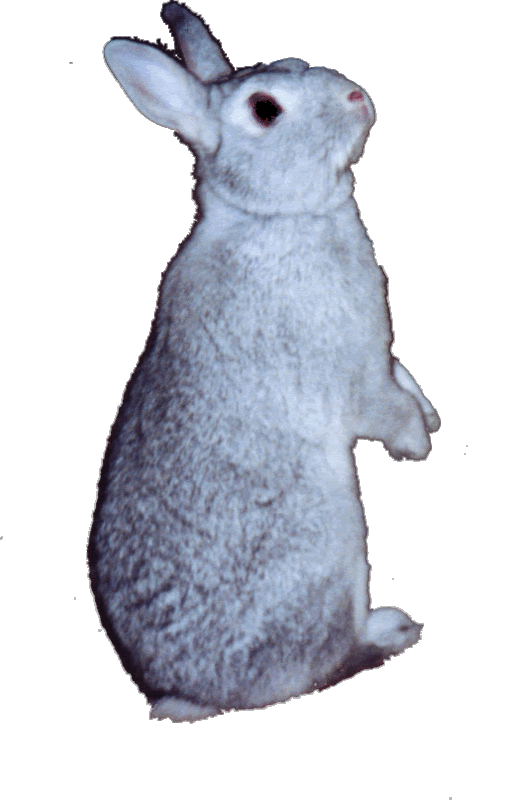

Our beautiful, beloved Netherland Dwarf, Pookah’s, current diet consists of a bunny-bowlful of crunchy carrot and dry lucerne pellets, topped with mint and parsley, all several times daily. Pookie also has slices of banana two or three times a week, sometimes as often as twice a day; and treats of crunchy apple or pear slices, several times a week, sometimes two or three times a day; as well as the occasional slice of peach or apricot, which he loves, and the odd single grape; and he loves a cherry with the pip removed! All this varies with the weather, too … bunny rabbits’ digestion is very sensitive, and can really be affected by weather changes. Thus we feed Pookie more pellets during cool weather, when there is less danger of dehydration, along with his everyday carrot slices, and mint and parsley pieces, but not as much apple or fruit. During warm weather, when hydration is an important issue for bunnies, he eats a lot more fruit and vegetables, as detailed above. And, at all times throughout the year, lucerne hay and water 24/7. Never give your bunny any food straight from the fridge - they are too cold and can cause stomach upsets - instead, keep bunny’s fruit and vegies in a bowl on the kitchen bench for a couple of hours before you feed him, so that his fruit and vegies are always room temperature.
Importantly, it is best to introduce vegetables and fruit very slowly … indeed, before six months, bunnies’ main diet should be hay, water, and lucerne pellets. Some say you can begin introducing vegetables at four months, some say not until six months of age. It also depends on what the baby’s mother ate, and what the baby bunny ate before you adopted her … so be sure to take note of this! Whatever the age, whenever you decide to introduce vegetables or fruit to a rabbit, you should begin very slowly … if you introduce too much vegetable matter, too quickly, you could give your bunny diarrhoea, and you certainly want to avoid that, given the complexity and sensitivity of bunnies’ stomachs. Begin with a small slice of crunchy carrot once a day, and if bunny tolerates this okay, with no diarrhoea, up it to two slices after a couple of days; parsley is one of the best greens for bunnies, but again, introduce this gradually too, just one piece for the first few days, and observe bunny’s droppings to see how he is tolerating his new food! Slowly and gradually does it. It’s important to keep in mind, whenever you introduce anything new, or change anything in a rabbit’s diet, whatever their age, just make sure that you do it very gradually … introduce new foods one slice at a time, change pellets over by gradually mixing them together. This will hopefully avoid any stomach problems such as constipation or diarrhoea.
A word of warning on foods to avoid … lettuce is one of the worst foods
for rabbits. It contains recognised properties which make it so
dangerous … lactucarium, an organic form of laudanum, which is the active
ingredient in opium … see
Lactucarium in Wikipedia, the Online Encyclopaedia
for the details. This can give a bunny life-threatening diarrhoea.
Iceberg lettuce contains the most lactucarium, Cos lettuce less than Iceberg
but still a rather high quantity, while Romaine lettuce has the least
lactucarium, but still contains some, nevertheless. So I recommend NOT
including lettuce in your beloved bunny’s diet at all, particularly when
there are so many other vegetables available, not only higher in nutritional
value, but also safer. And have you ever seen what lettuce decomposes into
if you leave it in the bottom of your fridge too long? It’s the only vegetable
which releases a toxic run-off which apparently causes problems in land fill
:-( Thus lettuce can ferment in bunny’s stomach too quickly, causing
constipation, diarrhoea, and bloat, which is very dangerous and potentially
fatal. We had a very frightening situation with our previous, beautiful
Netherland Dwarf rabbit, Dasher, who was always kept indoors as a
“house bunny”, and was a true and great friend and companion to us for nearly
six years. Dashie developed a severe case of bloat after eating lettuce, and
almost died … he eventually recovered, but always had a sensitive stomach
after that, and would alternately suffer constipation, and “scours”, diarrhoea.
In short, I urge every caring bunny owner never to feed any type of lettuce
to their bunnies.
One more thing … Pookie is heavily moulting at the moment (it’s
full-on summer here in the southern hemisphere, as I write this), and he has
had a couple of scary moments where he showed symptoms of furballs … though
he is having less of a problem with furballs this year, because we’ve upped
the carrot, mint and parsley (along with hay of course, as always).
Symptoms of furballs, constipation, gastric stasis, include bunny sitting
hunched up and looking uncomfortable, very small dry droppings, or worse a
complete absence of droppings, as well as strings of fur seen in the
droppings. These symptoms disappear very quickly when we feed Pookie
pineapple juice through a plastic syringe … pineapple reportedly contains
an enzyme which breaks down fur and other blockages, in addition to being
valuable for rehydration and continuing movement of his digestive system.
For details, see my page on
Bunny Digestive & Stomach Health - Constipation & Diarrhoea.
Below are lists of safe and desirable foods, and of poisonous plants
which should never be fed, as reproduced from the excellent book,
“Rabbitlopaedia: A Complete Guide To Rabbit Care”,
written by Meg Brown and Virginia Richardson, and published by Ringpress,
Gloucestershire, 2000, pp.27-30, p.38, pp.52-54. We ourselves have not tried
all these reputedly bunny safe foods listed below from this book, however
these lists may be helpful:
Safe Herbs:
Blackberry (general bunny tonic), Bramble,
Mint, Parsley (another excellent general bunny tonic), Raspberry Leaves
(general tonic), Rosemary, Sage, Strawberry Leaves, Thyme.
Safe Wild Plants:
Bramble, Bindweed, Burnet, Butterbur, Cow Parsnip or Hogweed, Coltsfoot,
Convolvulus, Chickweed, Geum, Goosegrass, Crosewort or Maywort,
Dandelion, Dock (not seeding), Groundsel, Goutweed, Hawkweed, Heather,
Hedgeparsley, Knapweed, Knotgrass, Lucerne, Mallow, Mustard, Nipplewort,
Plaintain, Sea Spinach, Shepherd’s Purse, Sour Dock or Sorrel, Thistles,
Trefoil, Vetches or Tares, Watercress, Yarrow.
A couple of warnings on wild plants:
firstly, if you are going to feed your bunny wild plants, be sure that
you definitely know for certain the type of plant you are choosing, as
plants go by different common names in various parts of the world - best
to err on the side of caution, and only feed plants which you know the
names of for certain, or which you know for certain are bunny safe;
secondly, be aware that, if you pick plants from public places, or any
place where you personally have not grown them yourself, you must be
absolutely certain that they have not been contaminated by pesticides or
other chemicals - again, best to err on the side of caution.
Safe Flowers:
Asters, Borage, Calendula, Carnations, Centaurea, Daisies, Galega,
Geranium, Geum, Helenium, Hollyhock, Honesty, Lupins (not seeds), Mallow,
Marguerites, Marigolds, Michaelmas Daisies, Nasturtium, Rose, Stocks,
Sunflowers.
Safe Trees:
wood prunings from fruit trees, with the exception of
stone fruit trees (again also ensure they
have not been sprayed with pesticides or chemicals), most deciduous trees
(but not Oaks), Blackberry, Rose, Raspberry Canes (with all canes, beware
of thorns, of course).
Hay (including grasses:
Kentucky Blue Grass, Fescue, Timothy, Lucerne, Rye Grass,
Yarrow), Dandelion (sparingly - a powerful diuretic).
Bread
can be fed, but is not ideal and only dried bread, never fresh -
no bread is ideal for bunnies, because of the yeast and the highly
processed ingredients.
Dangerous Wild Plants - always avoid:
Arum, Anemone, Bluebell, Buttercup, Bryony, Christmas Cherry,
all Clovers, Colchicums or Meadow Saffron, Comfrey, Corn Cockle,
Celandine, Deadly Nightshade, Docks (in seed), Dog Mercury, Figwort,
Fool’s Parsley, Foxglove, Honeysuckle, Iris, Jasmine, Lords and Ladies,
Ground Ivy, Hemlock, Henbane Poppies, Oxalis, all Poppies,
Scarlet Pimpernel, Spurges, Toadflax, Traveller’s Joy,
Wandering Jew, Yew.
Dangerous House Plants:
Arum Lilies, Bead Plant, Christmas Cherry, Cineraria,
Daffodils and all bulb plants, Devil’s Ivy, Dieffenbachia,
Fairy Primrose, Hedera, all Ivy, all Jasmines, Leopard Lily,
Monstera (Fruit Salad Plant/Swiss Cheese Plant), Miltonia,
Poinsettia, Pothos, Primula Obconica, all Primulas, Solanum,
String of Beads, Tradescantia, Wandering Jew or Wandering Sailor,
Winter Cherry, Zantedeschia.
Dangerous Flowers - always avoid:
Acacia, Aconite, Antirrhinum, Arum, Anemone, Cineraria, Clover,
Columbine, Daffodil, Dahlia, Delphinium, Feverfew, Gypsophila,
Helleborus, Honeysuckle, Hyacinth, Iris, Jasmine, Larkspur,
Lily of the Valley, Linarias, Lobelia, Love-in-a-Mist, Monkshood,
Oxalis, all Poppies, Primroses, Primula Obconica, all Primulas,
Snowdrop, Snowflake, Tulips, all bulbous plants, and
all flowers which grow from bulbs, are poisonous.
Dangerous Trees - always avoid:
most evergreen trees and shrubs, Acacia, Box, Elder, Beech,
Gorse, acorns, seeds, Ivy, Laburnum, Oak, Flowering Plum Trees,
all stone fruit trees, Snowberry.
Spurge, Fool’s Parsley, Feverfew.
Nightshade, purple or flowered white,
Lords and Ladies, Aconite.
Bryony with berries red,
Pimpernels should not be fed.
And Laburnum, Golden Rain,
Hemlock with its crimson stain.
Buttercup and celandine,
Foxglove, poppy and woodbine.
If they eat these, rabbits die,
Caution says, don’t let them try.
Reproduced from “Rabbitlopaedia: A Complete Guide To Rabbit Care”,


Site maintained by our Webmasters - contact us via email.

![]()
